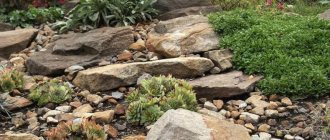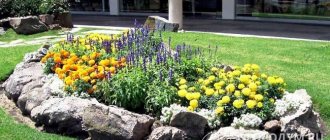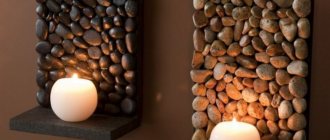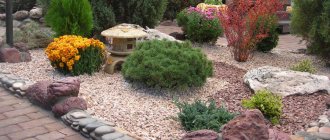Summer is the best time to arrange a suburban area. It doesn’t matter whether the area is large or small - with the help of stones, plants and furniture, you can give it a neat and elegant look, without depriving it of natural beauty. In order to create a design from stones, you do not need to have a landscape designer diploma. You can do it yourself. We have prepared for you step-by-step instructions on how to create a flower garden design from stones, tips on which stones and plants to choose, and also compiled an overview of the best garden furniture options that can complement your project.
Design of a flower bed with stones
Flower beds made of stones: types
When it comes to a flower garden with stones, one thinks of an alpine hill or rock garden, the creation of which follows certain rules (in a rock garden, stones dominate, and the vegetation is an addition; the rock garden imitates a flowering mountain slope).
Option for an alpine slide on the site
But there is another type of flower garden using stones: a flower bed, the perimeter of which is laid out from boulders or rock fragments, and the inside is filled with soil, that is, the stones serve only as a frame for the flower garden. There are 4 types of stone flower beds based on their appearance and structure.
Types of flower beds made of stones:
- A raised flower bed is a flower garden, fenced on all sides with a parapet. The fence can be low (40 cm) or high (over 1 m). To prevent the parapet parts from falling apart, they are held together with cement mortar;
- Multi-level - the flowerbed is made in the form of a cascade of several steps. There is a flower garden on each tier;
- From gabions - the parapet is made of a mesh box filled with stones. The configuration can be arbitrary: spiral, cube, circle, semicircle;
- Border – large boulders are used as a frame. Unlike a raised flower bed, the inside of the flower bed remains at the same level or is raised to a slight height, only 10-20 cm.
Stone flower beds are divided according to their purpose. In most cases, they are arranged as artistic compositions. But sometimes situations arise when it is necessary to smooth out uneven terrain, and then the parapet is erected as a retaining wall, and a flower garden is planted on it.
Advice. Stones can be used not only to decorate the perimeter. They are also laid out inside the flower bed, thanks to which a composition is created in a single design.
Choosing a location
You can place a stone flowerbed anywhere in the garden.
- Be sure to take into account the conditions necessary for the plants that are supposed to be planted there.
- Such a flower bed will definitely become an accent element of the design.
- A flower bed with stones will not require much attention.
Thinking through the idea of a composition
You can create a beautiful flower bed in different variations. Be sure to determine the type and type of flower garden. Perform composition planning. To do this, they create drawings, think through the content and layout. It is easier to carry out work on the ground according to a ready-made plan.
Where to make a flower bed from stones
You can choose a place for an original flower garden in any corner of the garden, regardless of the degree of illumination. Since the presence of stones will provide the flower garden with a share of originality, the composition will attract attention both in the front garden and in the backyard, near the resting place.
Particular attention should be paid to the choice of vegetation. If the flowerbed is located in an open space, sun-loving plants are planted in it, and if it is in a shady place, shade-tolerant plants are used.
In all other respects, you should adhere to the general principles of planting flower beds. They should not be placed in drafty places, in low-lying areas with stagnant rain and melt water. In addition, the location of flower beds should not interfere with movement around the yard and garden.
The most successful places for creating a flower bed made of stones are the front garden under the windows of the house, the space near the fence on the street side, along the wall of an outbuilding.
It will also look beautiful on the porch on either side of the steps.
Decorative pebbles for the garden
Pebbles are used for landscaping local and driveway areas, paving paths, and decorating lawns and flower beds.
Laying material in a circle for a decorative area Source skif.websmith.ru
This material looks harmonious with water features: swimming pools, fountains, artificial ponds.
Large boulders of natural shape Source yastroyu.ru
Using pebbles, you can create a platform for an outdoor summer shower.
Stones in a summer shower Source dkds.ru
What to make a stone flowerbed from
The main material for constructing a stone flower bed is natural stone. It looks natural when surrounded by vegetation, is durable and strong. What type of stones to choose depends most often on what exactly can be bought (or found in nature) in a given area. Of course, if you want to create a masterpiece flowerbed at your summer cottage, you can buy stone, in particular, through an online store.
Wild stone for a flower bed:
- Quartzite is a hard rock that comes in gray, reddish and yellowish shades;
- Sandstone is a layered material, easily sawn into flat plates, which can be used to decorate a parapet made of concrete or blocks;
- Limestone is a clastic rock of light gray colors, in rare cases with a pink, cream or yellow tint;
- Basalt is a beautiful and durable natural material, frozen volcanic magma;
- Granite is a valuable type of finishing stone that comes in all shades of gray and pink. Granite should be used with caution, as it has the property of oxidizing the soil;
- Pebbles - river and sea stones polished with water, laid out on a crushed stone or sand cushion in the form of a bordering contour in small-scale flower beds.
Natural materials
The moment of choosing a building material is very important. Natural stone looks best, as it has a number of advantages:
- strength,
- long century of service,
- availability,
- environmental Safety
- aesthetics
- resistance to environmental influences.
Decorating a flower bed with stones is a delicate job, which aesthetically very much depends on the selected material. Natural stone always provides an opportunity to achieve aesthetic excellence, which every lover of beauty strives for.
How to make a stone flowerbed
Creating a stone flower bed begins with markings. If the flower garden has a simple shape (rectangle, square), the layout can be made directly on the soil, marking the boundaries with a strip of sand or twine tied to pegs. A more complex configuration (for example, a multi-level flowerbed with several tiers) is first drawn on a sheet of paper and then transferred to the ground on a larger scale.
Preparing the Stones
The biggest attraction of the stone flower bed is the largest rock fragments. Free-standing elements must be stable enough so as not to pose a danger to the person caring for the flower garden. When a stone does not have a flat side and can turn over, its shape is corrected using impact tools (hammer, perforator).
If there is plaque, moss residue, mold or other dirt on the surface of the stone, it should first be cleaned mechanically (trowel, brush), and if this does not help, use chemicals. To do this, you can use alkaline pastes or acidic compounds (hydrochloric acid, phosphoric acid, acetic acid).
Important. Treatment of stones with chemicals is carried out away from the flower bed so that the composition does not penetrate into the soil. After cleaning, the surface of the boulders is washed with a strong stream of water.
Laying stones
First, the top layer of soil around the perimeter of the flowerbed is removed, and the earth is well compacted. The width of the groove depends on the width of the parapet, and the depth on its height: the more massive the fence, the wider and deeper the “pit” is dug. The depression is filled halfway with sand, and stones are laid on it in several rows. During installation, each boulder should be carefully selected so that it has the largest possible area of contact with other elements. If the wall is quite high, the stones are fastened together with cement mortar.
Two ways to put stones on the solution:
- All seams and voids between the stones, both on the front and on the inside of the flowerbed, are filled with mortar. The masonry turns out to be strong, but the mortar seam is visible in it;
- Only the internal voids are filled with the solution; the front part of the parapet is left as is. The masonry looks more natural, but water gets into the cracks, and when it freezes, the adhesion strength of the mortar to the stone decreases.
Advice. From constant contact with the ground, stones get dirty and don’t look very attractive. You can prevent contamination by treating them with a hydrophobic impregnation, for example, Remmers Funcosi SL. In addition to protecting against dirt, the product will emphasize the texture of the material.
Example of work made from wild stone:
Preparatory work
Using driven stakes and a thick long string (cord, wire), mark the outlines of the future flower bed, transferring them from the scaled drawing on paper. The sample for the diagram can be copied from a photograph from gardening magazines or you can think of it yourself. It is also worth making at least approximate calculations of material consumption in advance, deciding on the color scheme and choosing suitable plants.
A layer of soil 20-30 cm deep is removed from the site along a slightly larger perimeter than the intended structure. The base is leveled using a building level and reinforced with a metal grid or other rigid frame. For small compositions, it is permissible to cover the bottom with dense agrofibre or membrane. The grating and/or panel is fixed with staples or fastening anchors, the outer edges are covered with plastic or a flange is made to prevent the spread of small lightweight fractions and pebbles. Next, a drainage layer of the foundation is made with coarse sand interspersed with small crushed stone and construction waste, compacted thoroughly and leveled again.
When laying pieces of arbitrary shape, they are adjusted to each other as much as possible to achieve the greatest joint density
When constructing a high or multi-level flower bed, large fragments are laid out first, and smaller ones are installed on them. Periodically check the plane and measure the angle of inclination. The seams between the stones are filled during the laying process, applying the solution directly to the places of their contact, or the internal and external walls are coated with an adhesive compound after completion of the work.
To ensure ease of maintenance and reliability of the flower bed, it is necessary to thoroughly fasten the stones together. Without the use of cement-concrete mixtures, if necessary, the volumetric creation can be disassembled, moved or remodeled in the future, but in this case, to increase stability and to avoid accidental collapse, it is more advisable to limit ourselves to a minimalist structure. Here it is quite justified to assemble a wide flower bed with compacting soil filling the cracks and free space, as well as container planting of “green inhabitants”.
After the building is folded, it needs to be given at least a day or two to shrink and dry. Then the soil is poured and the plants are planted.
The final stage of work is finishing, for example, filling the area around the flowerbed itself or the plants planted on it with gravel or bark
Gabions made of durable wire mesh with anti-corrosion properties are usually filled with uniform fragments of rubble stone.
How to make a flowerbed out of brick
Near a brick house, a brick flowerbed looks natural. Masonry can be done on a lightweight concrete foundation or on a sand and crushed stone bed. For aesthetic reasons, the concrete base should not rise above the soil level. If the masonry is made of facing bricks, it does not require additional finishing - the main thing is to make a neat jointing.
Old brick is also suitable for creating a flower bed. You can even use broken material and halves. The fragments are laid out on cement mortar, just like a whole brick, the only difference is that more mortar mixture will be needed to fill the joints. After the cement has set, the wall is lined with clinker tiles to resemble brick or wild stone. It can also be lined with flat slabs of sandstone, shale, limestone, and basalt tuff.
A few weaving rules:
- Do not start weaving the rod from the corner pegs. Start somewhere in the middle so that the branch, when weaving, passes the corner and ends on the other side of the perimeter. Then the corners will be prettier and the structure more stable.
- Align the thick end of one rod with the thin end of the next so that the knitting is even.
- Make sure that the end of the vine does not fall on a peg where there is already another tip from the previous layer. Either choose a vine of a different length, or shorten this one.
- To make the fence stronger, you can additionally tie them with rope in several places, for example, on the corner stakes.
- By adjusting the distance between the vertical stakes, you can make the fence more or less densely woven.
And finally, after finishing the work, trim the protruding edges of the rods - cut with a knife or pruning shears. That's it, the fence is ready!
Flowerbed made of slate and tiles
After building a house, sometimes “free” materials remain, which can also be used in arranging the garden landscape. In particular, slate (flat, wave) and tiles are suitable for creating a raised flower bed.
First, the slate is cut into sheets of equal size. Please note that they will be dug into the soil, so they need to be made approximately 1/3 higher than the expected height of the flowerbed. Next, the territory is marked, narrow grooves 30-50 cm deep are dug along the marked lines, and slate is installed in them in a vertical position. The remaining space between the slate and the walls of the groove is filled with earth and pressed down.
To prevent the flower bed from deforming under the pressure of the earth poured inside, wooden (metal) supports are installed on the outside. The distance between the supports depends on the height of the flower bed and the length of the slate sheets and ranges from 80 cm to 1.5 m.
If tiles are used, there is no need to cut them, just all the elements are dug into the soil right next to each other. In this case, you need to ensure that they are all at the same height and form an even line.
Advice. Not only a flower bed is built from slate, but also vegetable beds. A garden divided into sections looks tidier and is easier to care for, since the plants are located above the normal soil level.
Plaster laying options
To emphasize the natural beauty of the landscape in the yard, they use plastic. The material is a tile of the same thickness with various geometries. The stone is gray-green in color, but may be yellow or reddish. Untreated plastic has a lower cost than polished one.
You can place stones in the yard in the following ways:
- In rows. The flatbed in the yard is laid out “in a running start”. The gaps between the stones are filled with crushed stone or soil. In between, you can sow grass seeds.
- The material is laid out in scaly-arc-shaped or segment-arc-shaped patterns. To make the yard look nice, it is important to ensure that you get full-fledged pictures on the surface when laying.
- Arbitrary arrangement of stones in the yard. To obtain a beautiful coating, it is recommended to invite professionals who specialize in paving yards with plastic.
The composition of the plaster includes sandstone, quartzite, dolomite, shale, shungite. For installation, it is recommended to choose stones with a thickness of 3–5 cm.
Tips for creating a landscape with a rock bed
The advantage of a flower garden made of stones is that its design does not need to be squeezed into established frames, as is the case with a rock garden or rock garden. It can be adapted to any landscape, varying in size and configuration.
Japanese garden
The use of stones is always appropriate in a Japanese-style garden, in which rocks coexist with coniferous vegetation. You can include a stream, cascade or small pond in the composition.
The parapet made of flagstone looks interesting. The stones are laid flat on top of each other, selecting the most beautiful and even cuts on the front side. For greater strength, the stones are glued together with tile adhesive, but so that the adhesive mixture does not protrude outward.
Gabions
Gabion flower beds are popular. You can buy them ready-made or make them yourself. A double-walled box is constructed from welded mesh, and the space between the grids is filled with small stones or pebbles. Soil is poured into the interior and plants are planted.
Gabions are decorative in themselves, so it is not necessary to include lush flowering plants into the composition. It can be supplemented with ornamental cereals and ordinary field herbs: eryngium, scabiosa, gentian, thyme.
Gabion construction technology
The metal mesh is fixed in the ground; the methods we mentioned are suitable here. It is possible to fix the mesh with cement for strength, but in this case it will be impossible to vary the shape of the gabion. Therefore, it is usually dug in without the use of cement materials.
This type of material differs from others in its flexibility and lightness. Flowerbeds can be made into any shape depending on your wishes.











